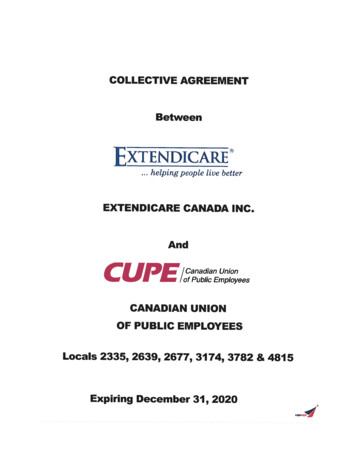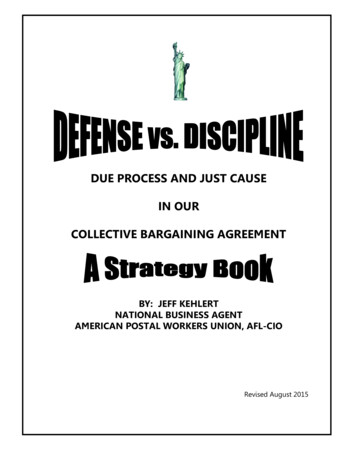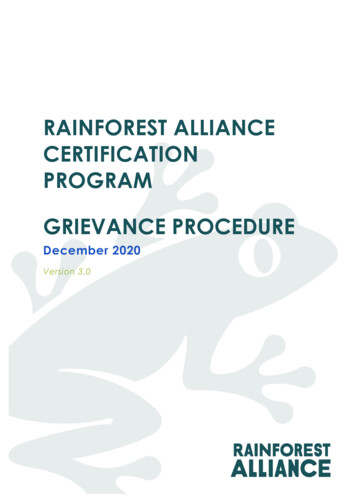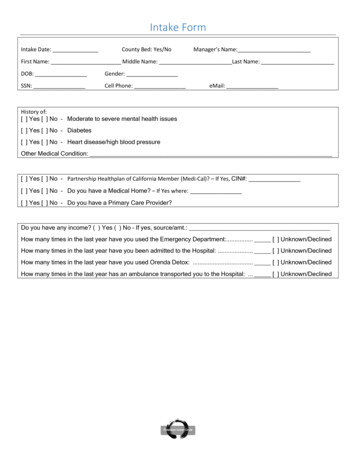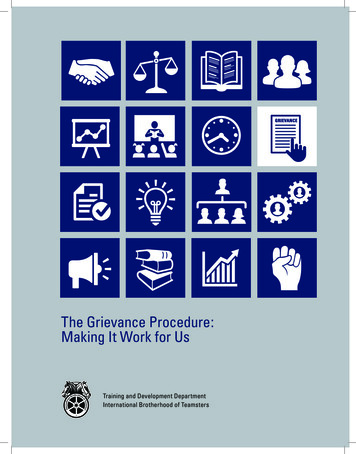
Transcription
GRIEVANCEThe Grievance Procedure:Making It Work for UsTraining and Development DepartmentInternational Brotherhood of Teamsters
Table of ContentsIntroduction . 2Overview . 3What is a Grievance? . 5Steps in the Grievance Procedure . 9Investigation Fact Sheet . 12The Three Rules of Evidence . 13Writing the Grievance . 14Sample Grievance Report Form .15Presenting and Settling the Grievance . 16The Oral Presentation . 17Arbitration . 19The Law and Grievance Handling . 22The Duty of Fair Representation . 23Access to Employer Information . 27Investigation Checklist . 29
IntroductionThe Teamsters Union has always fought hard for strong contracts for our members. Membersrely on the union through these contracts to guarantee wages and benefits as well as to protecttheir rights at work. As a Union representative, it’s your job to make sure stewards and membersunderstand their contract and know how to enforce it.The vehicle to enforce most contracts and protect the rights of workers in the work place is thegrievance procedure. The grievance procedure is perhaps the most valuable and commonly usedsection of the contract, and it is our responsibility to use it as effectively as possible.However, the grievance procedure has limitations. Sometimes management lets grievance pileup and deliberately causes long delays in settling. Other times members have legitimateproblems that cannot be solved by the grievance procedure because of the way the contract iswritten.That means we sometimes have to look at other ways to address members’ problems in additionto, or instead of, filing grievances. Some of the ways we do this include: showing membershipunity, filing a complaint with a government agency, involving public officials, organizingcommunity pressure or using the media. It is up to the union to figure out the most effective wayto respond, but the goal is to show management that it is in their interest to take the grievanceprocedure seriously and make it work.How we help members solve their problems can help shape the image of the union. Supportfrom the members increases when they play a role in union activities. Some of the tacticsmentioned above, as well as the grievance procedure, can be an opportunity to get membersinvolved through investigating the situation, meetings with management, figuring out possibleresolutions, and carrying out actions designed to encourage management to resolve problemsquickly and fairly.This section focuses on guidelines for more effective grievance handling. It is intended to givebasic information to determine if a grievance exists, how to investigate, how to handle a meetingwith management and what laws may affect the process of grievance handling. The informationcan be adapted to meet the particular problems in your local.Using the grievance procedure effectively is one of the skills Teamster leaders need to representour members. While there are no prescriptions for handling every problem, the manual will helpyou develop the confidence and techniques to build the membership support the union needs tobe able to represent the members to the fullest.2
OverviewInvestigate and prepare1.2.3.4.5.Get the who, what, where, when, why of the problem and be aware of time limits.Interview the grievant and identify the contract clauses that may have been violated.Interview the witnesses and get the relevant documents.Re-evaluate the work problem after your investigation.Discuss the strengths and weaknesses of the case with the member.Handling a work problem that is grievable1.2.3.4.Determine whether there is a violation of the contract.Cite every provision of the contract which may have been violated.The Employer must have “just cause” for disciplinary action.Upon request, a member is entitled to your presence at a management investigatoryinterview that could lead to discipline.5. You have a Duty of Fair Representation of grievant.Handling work problems that are not grievable1. If the work problem is not grievable explain and discuss why with the grievant.2. Discuss alternate ways to resolve the problem.Try to resolve the grievance informally1.2.3.4.Find out management’s position.Explore settlements (see “Settling the Grievance” below).Discuss the strength of the case and next steps with the grievant.If an informal settlement is not reached, tell management a written grievance may be filed.Writing the grievance1.2.3.4.Write a clear, simple, brief description of what happened to cause a grievance to be filed.Cite contract articles violated and add, “and all other relevant contract articles and rules.”Ask for a remedy and include, “and all other benefits to which the grievant is entitled.”Watch for opportunities to file group grievances, policy grievances, or union grievances.3
Presenting the grievance1. Follow the contractual time limits at each step of the grievance procedure.2. Never present the grievance without the grievant being there.3. Keep copies of the grievance at each step and each written response. Also, keep notes ofmanagement’s statements in grievance meetings.4. You have a protected right to vigorously represent members.5. If employees want to handle their own grievances, the employer must notify you; you have aright to be present, and the adjustment must be consistent with the contract.Settling the grievance1.2.3.4.Never settle a grievance without consulting the grievant.Always get a grievance settlement in writing.Don’t miss a time limit while waiting for a settlement.Be aware of any precedents you may be setting.Arbitration1. Investigate every grievance as if it might go to arbitration.2. Learn about arbitrators’ standards – check grievance guides and previous decisions.4
What is a Grievance?The dictionary defines a grievance as any “circumstance regarded as just cause for protest.”“Grieving” such a circumstance is the formal act of making a complaint. The person or personson whose behalf you are filing a grievance is known as the “grievant.”Teamster collective bargaining agreements, or contracts, may define a grievance in several ways.One agreement may state that a grievance is “a dispute between the union and management overthe application and/or interpretation of the agreement.” Another contract may define a grievancemore broadly as “any dispute or difference arising between an employee and management orbetween the union and management.”Look at your Teamster contract to find the definition of a grievance as it applies to yourworkplace.Many contract grievance procedures make it possible to grieve violations of state, provincial,municipal and federal law, company rules or policies, unfair or disparate treatment of workersand “past practice.”To help you decide if an issue in your workplace is a grievance, look at each problem fromdifferent points of view with each of the following in mind:The ContractContractual grievances include violations of the contract, memoranda of understanding, sideletters, and previous arbitration awards that have interpreted the contract.Grievances based on violations of the contract are the most common and often the easiest to win,especially where the violation is clear cut. A grievance may be more difficult to resolve whenthe contract language in question is unclear or ambiguous, two or more contract clauses are inconflict, the facts surrounding the problem are not clear, or management is being stubborn.Even when the contract is silent, however, you still may be able to grieve a problem on one ofthe following grounds:The LawLocal, state, provincial or federal laws always supersede the contract when the contract is inviolation of the law. For example, if your state’s wage and hour law requires that employees bepaid time and one-half after eight (8) hours and forty (40) hours, and your contract calls for timeand one-half only after forty (40) hours, the law will prevail.5
Filing a grievance based on an alleged violation of the law does not prevent you from alsopursuing legal remedies. However, a grievance is often the quickest way to get management tocomply with the law. Informing management of a violation of the law also can give the unionthe leverage it needs to resolve the grievance. Additionally, it may be necessary to first givemanagement an opportunity to resolve the problem before pursuing a legal remedy.Employer Rules and PoliciesWhile employers are obligated to abide by the contract, they also have the right to make andimplement rules related to the orderly and efficient operation of the business, so long as: they provide notice to the employees and the union,the rules are reasonable “on their face” andthe rules are reasonably and fairly applied.Management’s uneven or unequal enforcement or disregard for its own rules, are commongrounds for a grievance. For example, the union may use the employer’s own policy prohibitingsexual harassment to defend a worker being harassed by a supervisor.Unfair or Disparate TreatmentDisparate treatment occurs when two people are treated differently in the same or similarsituation so as to harm or negatively affect one of them.Grievances based on unfair or disparate treatment can cover a broad range of incidents andbehavior. For example, there does not have to be a specific contract clause covering asupervisor’s harassment of employees in order to grieve such treatment.The terms “disparate treatment” and “discrimination” are often used interchangeably, althoughthe work “discrimination” may lead you to think of unfair or illegal treatment on the basis ofrace, color, national origin, gender, age, sexual orientation, etc.Disparate treatment is much broader and includes treating someone differently because of theirpersonality, appearance, past incidents and experiences, or union activity.While disparate treatment complaints are common, they are often very difficult to prove.Successfully resolving a disparate treatment grievance requires a significant amount ofdocumentation and often requires the union to show a pattern of objectionable behavior by asupervisor.6
Past Practice“Past Practice” is a term you may hear often as a steward. A short definition of a past practice isany long-standing practice that: occurs regularlyboth union and management have accepted and/or not challengeddoes not violate the contract or any written company rulePast practices usually cover situations where the contract is silent or ambiguous. A past practicegrievance usually arises when management unilaterally, and without notice to the union, changesan established procedure or disciplines a worker for following a past practice.For example “wash-up time” was once a common practice. A company allowed workers toleave their work areas fifteen minutes before the end of the shift to wash-up before clocking out.When the company changes the practice without notice to the employees or union, thendisciplines an employee for following the practice, the union can file a grievance based on aviolation of past practice.These guidelines will help you determine if a past practice violation has occurred. Uniformity – Was the policy consistently applied over a period of time and did atleast a majority of the employees have the opportunity to enjoy the practice?Longevity – The longer the period of time a policy has been in effect, the strongerthe case for it being considered a past practice.Acceptance – Both the union and management know that the practice has been ineffect, and neither party has objected.No Written Language – There is nothing in writing either in the contract or inwritten company rules regarding the practice. Written language supersedes pastpractice.Past practices are often difficult to establish. Past practice grievances have become less commonin recent years, as there are fewer practices not covered by work rules or contract language.For example, the NLRB has ruled that employer gifts such as a Christmas bonus or aThanksgiving turkey are gratuities and cannot be considered past practices. Management’s rightto direct its work force and change operating procedures if it does not conflict with contractlanguage has been upheld in numerous arbitrations. Furthermore, lax enforcement of a rule doesnot create an enforceable past practice. Finally, even if a past practice meets all of the criterialisted above, an arbitrator still may refuse to uphold the grievance.7
Determining “Just Cause”In nearly all Teamster contracts, and as a matter of law, an employee can only be discharged(fired) or disciplined for what is termed “just cause.” Determining whether or not the employerhas, in fact, established just cause for the discharge or discipline of an employee can be acomplicated matter.Answering the questions below can help you determine whether or not a discharge or disciplineis based on just cause.Was the employee adequately warned? (Exceptions: insubordination, drinkingon the job, stealing)Was the rule or order reasonable?Was the investigation fair and objective?Did the investigation produce substantial evidence or proof?Were the rules, orders and penalties applied evenhandedly and withoutdiscrimination?Was the penalty reasonably related to the seriousness of the offense and thepast record?8
Steps in the Grievance ProcedureThere are typically three steps in a grievance procedure. However, each Teamster contract spellsout the particular process that applies to you and your co-workers. Read the contract carefully.Step 1The steward and the grievant meet with the supervisor to resolve the grievance.Step 2If there is no settlement at Step 1, a representative of the union, the grievant, and a representativeof worksite management meet to try to resolve the grievance.Step 3Some Teamster contracts provide for an additional meeting between the local union andcompany management. Others involve a grievance panel composed of representatives of boththe union and management. Still others involve arbitration by a third party chosen by both sides.InvestigationThere are many ways to investigate and handle workplace problems. Teamster leaders developmethods that work best for them in the various situations they confront. Refer to theInvestigation Checklist at the end of this handbook. The following are suggestions to help youalong the way.Listen to the ProblemWorkers come to you with a wide variety of problems. Before you can determine the best wayto handle a situation, you need to find out as much as you can a about the problem. The first stepis to hear the worker out – give him/her a chance to describe the problem and cool off. Thismeans active listening. Stop what you are doing.Take the person aside to a place you can talk without being interrupted.Face the person squarely. Make eye contact, but do not stare the person down.Assume a relaxed, attentive posture – even if you don’t like the person.9
Start your interview with “open” questions. For example, “What seems to be theproblem?” or “Tell me what happened.”Give the person feedback with your body and words that encourage him/her tospeak. Show him/her that you are listening. For example, “Uh-huh,” “Yes, goon,” “I see,” nods of the head, lean forward slightly, etc.Recap the points made by the person periodically to make sure you understand.For example, “So this happened and then that happened.?”After the worker has told his/her story and you have a general understanding of the nature of theproblem, you can then begin to use specific questions to elicit more detailed information.Investigate and Get the FactsHere are some questions that can help you get information about a potential grievance. They areoften referred to as the “Six W’s:” Who, When, Where, Why, What, and Witnesses.Who is involved?This includes the full name, employee number, department, job classification, pay rate, shift andseniority date of all the people involved: the worker(s) with the complaint, witnesses, and thesupervisors(s).When did it occur?Be as accurate as possible about the time and date the grievance and related events took place.Where did it occur?The exact location where the grievance occurred, i.e., machine, aisle, department, floor, etc.Why did the situation occur?What contract language, work rules, laws, etc. were violated?What happened? What are the demands for settlement?What does the grievant want? What is needed to restore the worker to the same position she/hewould be in if the injustice had not occurred? For example, if any employee was discharged, thedemands for settlement may be reinstatement with back pay and benefits.Werethere any ionbe availablefrom thethepersonwith suchthe grievance.But until now you haveheard only his/her side of the story. There are other sources of information you should use in the grievantco-workerswitnesses to eventsother union representatives and officers10
It is usually best to get management’s side before you begin to fight the case. Hearing both sidesgives you a better idea of the facts and lets you know management’s reasoning for its decision.Records that can supply information: (For a more complete list, see Access to EmployerInformation, pages 28 and 29) grievance files, arbitration decisions (available from your local union businessrepresentative)the contract and any supplemental agreementscompany rule books and work rulesseniority, job classification and payroll listspersonnel, production, absentee and medical records and files.Keep Records of Workplace ProblemsAs you carry out your investigation, it is a good idea to record all the information you receive ona Fact Sheet. It is meant to be used before you have determined whether or not there is agrievance.It is also beneficial to keep all Fact Sheets and other records on members’ workplace problems ina convenient location – in a file folder, notebook or a centrally-located file cabinet or drawer.This information and the records of other stewards would then be available to refer to whensimilar problems occur.Often the difference between winning and losing may depend on the completeness and accuracyof the investigation, the records and the union’s ability to evaluate it properly.11
Investigation Fact SheetDEPARTMENTDATESHIFTSTEWARDNAME OFEMPLOYEE(S)CLASSIFICATION SENIORITY DATENAME OF SUPERVISORWHAT HAPPENED:EMPLOYEE STORY: WHENWHEREDATE OF INTERVIEW WITH EMPLOYEE(S)SUPERVISOR STORY: WHEN WHEREALLEGED CONTRACT/ RULE VIOLATIONDATE OF INTERVIEW WITH SUPERVISORWITNESSES' NAMES:WHAT THEY WITNESSED:DOCUMENTS NEEDED (CHECK "YES" WHEN RECEIVED AND ATTACH TO THE FACT SHEET)ATTENDANCE RECORDWORK RECORDMEDICAL RECORD***USE BACK OF THIS FORM TO RECORD ADDITIONAL INFORMATION***12
The Three Rules of EvidenceBefore proceeding, review the Fact Sheet and evaluate the information using the "Three Rulesof Evidence."1. Opinions are not facts All opinions must be specificallyqualified. If a person says "always," ask "how often/when?"2. Hearsay evidence is not factual Search for the originalsource and witnesses and get the first-hand scoop. If someonesays, "Mary heard." or "John told me that." find out directlyfrom Mary or John what happened.3. Facts must be relevant You need to identify the facts thatdirectly bear on each particular grievance. Review the FactSheet again and underline those facts that are relevant toproving this is a grievance.Should We Grieve?Now that you have the information necessary to decide whether or not a grievance exists,evaluate all the information carefully, make the decision, and plan a course of action.If you have fully investigated the problem and still feel the case is not strong, ask for advice frommore experienced union representatives and officers. However, always give the grievant thebenefit of the doubt. A good rule of thumb to follow is: even if you have a reasonable doubt thata grievance exists, GRIEVE!If after your investigation, you decide there is no basis for filing a grievance, discuss the problemwith the grievant. Even though you may not believe a formal grievance can be filed, there maybe other solutions to the problem.For instance, the problem may involve complaints against other members, the union or off-thejob problems. In these situations, you can refer the member elsewhere for help: to government,professional or community service agencies.Also, inform the member of his/her right to appeal your decision through the local union. Yourresponsibility of fair representation is fulfilled if you fairly and completely investigate the caseand make your decision to grieve (or not to) based solely on the merits of the case (See Duty ofFair Representation pp. 17 - 20).13
Writing the GrievanceHere are some suggestions for completing a written grievance form.1.Limit statements to the basic facts. The purpose of the written grievance is totrigger the formal steps of the grievance process and notify the employer of thebasic facts, alleged violation and the requested remedy. Limit the grievance tothose essentials by using the “Six W's” as a guide.2.Leave out arguments, evidence and justifications. Arguing the merits of thecase is reserved for face-to-face meetings with the employer. Disclosing thisinformation in the written grievance could give the employer an edge inpreparing their case against the union.3.If required, refer to all contract violations. If your contract requires includingreference to contract language, include all contract provisions that may beapplicable to this particular grievance. You can use the phrase "violates thecontract, including but not limited to Article ." This may allow you to addadditional violations of the agreement later.4.State the union's position. In clear, affirmative statements, express the union'sposition i.e., "Mary Smith was unjustly discharged." Avoid using phrases suchas, "I think" or "Mary believes."5.State a full, possible remedy. The purpose of the grievance procedure is to"make the grievant whole" by putting the worker in the same position he/shewould have been in had the injustice not occurred. If a worker has beendischarged, ask that he/she be made whole: immediate reinstatement with fullback pay and all rights, privileges and benefits restored, and the entire matterexpunged from his/her record. This makes it possible for the grievant to receivehis/her job back, plus back pay, seniority, vacation time, fringe benefits, etc.Remember, you get only what you ask for.6.Consult with the grievant. Go over the written grievance with the worker(s)on whose behalf the grievance is being filed, explain what the requested remedyis and make certain the grievant fully understands.7.Have the grievant sign the grievance form. This guarantees that the grievanthas seen and read the grievance and provides legal protection for the union whendetermining the final settlement of the grievance. The exception is that if thegrievance does not concern discipline, the steward may sign a grievance onbehalf of the union in order to stop a contract violation.14
Sample Grievance Report FormDATEMEMBER’S NAMEEMPLOYERHOME PHONEHOME ADDRESSDATE OF HIRECLASSIFICATION OR JOB TITLEDEPARTMENTTYPE OF GRIEVANCE (CHECK):DISCHARGE DATEWAGE CLAIM DATESUSPENSION DATEWORKING CONDITIONS DATEWARNING LETTER DATEOTHER DATEHAS GRIEVANCE BEEN DISCUSSED WITH SUPERVISOR?YESNODATEIF NO, STATE REASONHAS GRIEVANCE BEEN DISCUSSED WITH SHOP STEWARD?YESNODATEIF, NO STATE REASONSTEWARD’S NAMESUPERVISOR’S NAMEWITNESSES’ NAMES (IFAPPLICABLE)CONTRACT ARTICLES VIOLATED and any other relevant articles of the contract.FACTS OF THE CASE(MEMBERS SHOULD RECORD HERE THE CIRCUMSTANCE OF THE GRIEVANCE MAY USE BACK.)REMEDY ASKED andall other benefits to which the grievant is entitled.STEWARD’S SIGNATUREMEMBER’S SIGNATURE15
Presenting and Settling theGrievanceOnce you have fully investigated the case and decided it should be grieved, prepare yourself andthe grievant to give the best possible presentation to management. Your goal is to solve theproblem at the lowest step of the grievance process. Careful preparation will make this morelikely.Building Your CaseYour presentation to the supervisor may use all the facts you have written down on the FactSheet or only part of them. You may want the grievant to participate in presenting his/her case,or you may want them to remain silent. As a rule, the steward should do the talking.Nevertheless, you should decide these issues beforehand and discuss with the grievant how youthink the case can be presented. In order to be effective, you should:If you and the grievant are well prepared, you may be able to resolve the grievance at Step I.1.2.Build the Best Case - Decide what issues, facts, argumentsand remedies you think are most convincing. Write themdown separately so you can refer to them as you talk with thesupervisor. Know what you want to say before meeting withmanagement.Anticipate Management - Based on what you foundout during your investigation of the grievance, putyourself in the supervisor's shoes. Anticipate whatfacts, arguments and remedies he/she is likely to offer.3.Prepare Responses - Based on what you expect the supervisorwill argue, prepare responses, counter arguments andcompromises (regarding the facts and remedies) you and thegrievant are willing to accept.16
The Oral PresentationYou are now ready to present the grievance. Here are some suggestions to keep in mind: Take Control. In any meeting with management, the objective is for you tocontrol the tone, direction and outcome of the meeting. You do not have to beoverbearing, aggressive or argumentative to do this. Try to make managementpresent first. It is easier to poke holes in their arguments than to prove a workerinnocent. Set the Tone. The "proper" tone will depend largely on the situation and thetype of relationship you have with the supervisor. Usually the best approach isto be direct and positive. Be Calm, Don't Threaten. Shouting and pounding on the desk rarelyaccomplishes anything. Don't make threats that you and the supervisor knowyou can't carry out. If you and the supervisor can't come to an agreement, thereare additional steps to follow, including arbitration. Avoid Personalities. It is not who is right, but what is right that counts. Stayfocused on the issue at hand, and don't allow yourself to be sidetracked. Whenyou must disagree with what the supervisor says, do so with dignity.Remember, you are seeking agreement, not conquest. You will have to settleother issues with the same supervisor in the future. Listen. Despite your best efforts, you may not know all the facts. You want tomake sure you understand management's real position. Acknowledge Valid Points, Then Redirect the Discussion to the Union'sPosition. Example: "We understand your concern about meeting productionstandards, however, that does not mean you can ignore the contract." You areasking for justice, not favors; be as fair as you expect management to be. Caucus. Take a short recess if you need to regroup, discuss matters orsettlement proposals, or when there is division or disagreement among memberson your side never disagree in front of management. Don't Trade Grievances. Don't give up one grievance case in order to get afavorable decision on another. Management Has Rights. Both the workers and management must live up tothe terms of the agreement. Always leave the other side some graceful way outof a mistake.17
Finally, and most importantly: Keep written records of all grievances. After the meeting with management,write a brief summary of who participated in the meeting, what happenedand any settlement that was discussed or offered. Keep this in a file orenvelope with the other materials pertaining to the grievance. Keep the worker(s) informed about their grievance. You always shouldhave the grievant with you in any meeting with management regarding theirgrievance. If the grievant begins to lose his/her cool, ask for a caucus togive the member an opportunity to calm down - then proceed with themeeting.Settling the GrievanceRemember that in the grievance procedure, the supervisor and Teamster steward orrepresentative are equals and share the responsibility for settling the grievance. Keep inmind the following:IF the supervisor wants to trade (you win a grievance and management wins one), insiston settling each grievance on its merits. This is the only just way to settle a grievance.IF the supervisor stalls, try to push for an immediate answer. If you can't get a decision,try to set a definite time (as early as possible) to get an answer.IF you can't settle the grievance, determine if you are going to take the case to the nextstep of the grievance procedure. Be aware of time limits and be sure to keep the grievantinformed.NEVER settle a grievance
However, a grievance is often the quickest way to get management to comply with the law. Informing management of a violation of the law also can give the union the leverage it needs to resolve the grievance. Additionally, it may be necessary to first give management an opportunity to resolve the problem before pursuing a legal remedy.


